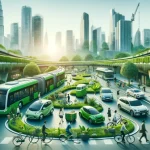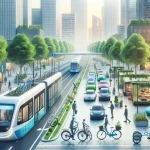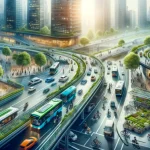
How can we make transportation sustainable? With simple, effective strategies. Dive in for eco-friendly transit tips!
Making Transportation Sustainable
Key Takeaways:
- Making transportation sustainable involves:
- Embracing electric vehicles
- Boosting public transit
- Promoting walking and cycling.
- It’s about creating efficient, low-emission travel options that reduce our carbon footprint and support a healthier environment.
- Simple changes in our daily choices can lead to a significant positive impact on our planet.
Wondering how we can make transportation sustainable? You’re not alone!
In our journey towards a greener planet, rethinking how we move around is crucial.
From cycling and walking to electric vehicles and public transit, there are endless ways to make our commutes cleaner and more sustainable.
Join us as we explore innovative ideas to transform transportation into an eco-friendly adventure.
How Can We Make Transportation Sustainable?
Making transportation sustainable is essential in our efforts to reduce environmental impacts.
This involves adopting strategies that shift our reliance on fossil fuels to more eco-friendly transport modes.
Such changes are vital for combating climate change, improving air quality, and enhancing urban life.
This section outlines practical steps and examples to guide us toward sustainable transportation solutions.
What Is Sustainable Transport?
What do we mean when we talk about sustainable transportation? It goes by many names and may be called Green Transport, Sustainable Transport, or Eco-Friendly Transportation.
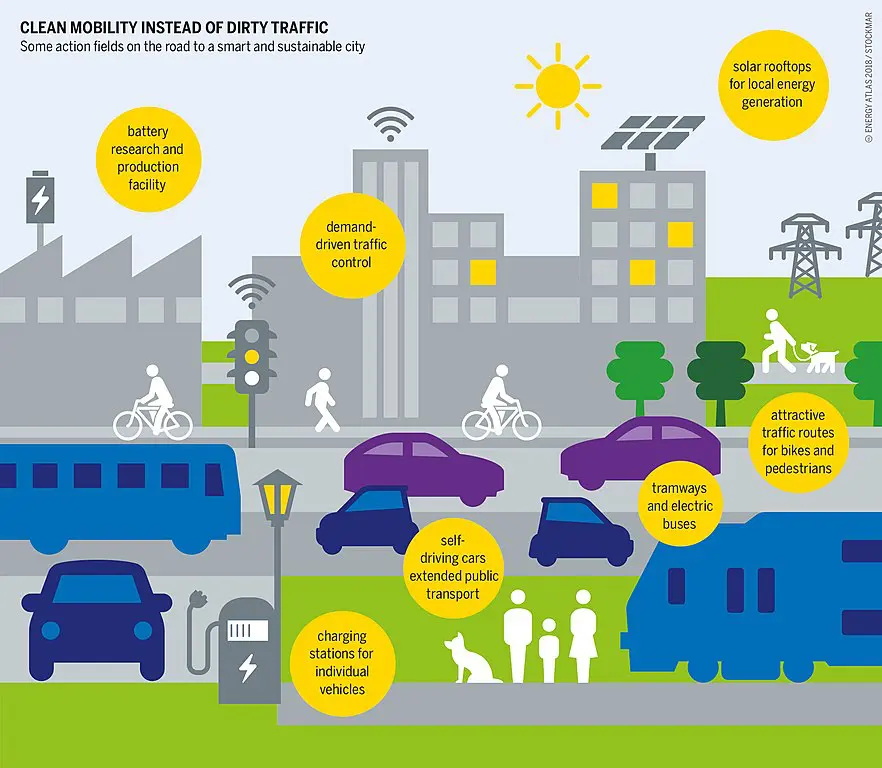
Sustainable Transport Defined
Sustainable transport refers to ways of transportation that are sustainable in terms of their social and environmental impacts. Components for evaluating sustainability include the particular vehicles used for road, water or air transport; the source of energy; and the infrastructure used to accommodate the transport. Wikipedia
Electric Vehicles (EVs): The Role of EVs in Reducing Carbon Emissions
- Transition to EVs: Encourage the shift from gasoline-powered vehicles to electric vehicles (EVs) to significantly lower carbon emissions. In the United States, initiatives like tax incentives for EV purchasers and grants for EV charging infrastructure aim to boost EV adoption.
- Success Stories: Norway is leading the charge with over 60% of new car sales being electric, thanks to comprehensive government policies including tax exemptions, toll waivers, and free parking for EV owners.
Public Transportation: Enhancing Accessibility and Efficiency
- Upgrade Public Transit: Enhancing the efficiency and accessibility of public transit can reduce the need for private vehicle use. Cities like Copenhagen have invested in extensive and efficient public transportation networks, making it easier for residents to choose transit over cars.
- Case Example: Tokyo’s integrated and punctual public transportation system, supported by government investment and planning, significantly reduces the city’s reliance on personal vehicles.
Cycling and Walking: Encouraging Non-motorized Forms of Transport
- Develop Bike and Pedestrian Paths: Investing in safe and accessible bike lanes and pedestrian pathways encourages walking and cycling. Amsterdam and Copenhagen are exemplary cities where cycling infrastructure is a priority, leading to high rates of cycling for daily commutes.

- Community Initiatives: Programs like Bike to Work Day or city bike-sharing systems can promote cycling and walking. Paris’s Vélib’ bike-sharing program is a great example of encouraging residents and tourists to cycle rather than drive.
Policy and Infrastructure: How Government Actions Can Support Sustainable Transport
- Implement Sustainable Policies: Governments can play a pivotal role by enacting policies that support sustainable transportation. This includes urban planning that prioritizes public transit, cycling, and walking over car use.

- Infrastructure Investment: Successful examples include the expansion of public transit systems in Bogotá with its TransMilenio bus rapid transit system, which serves as a model for efficient, affordable public transportation.
Innovation in Mobility: Exploring New Technologies and Their Potential
- Adopt New Technologies: The future of sustainable transportation lies in embracing innovations such as autonomous electric buses, which are being tested in cities like Singapore to improve public transit efficiency.
- Smart City Initiatives: Implementing smart city technologies can optimize traffic flow and reduce congestion. Barcelona’s smart city project uses sensors and data analytics to manage traffic, improve parking availability, and enhance public transportation routes.
By focusing on these specific strategies and real-world examples, we can illustrate the diverse ways to make transportation more sustainable.
Each point addresses common questions and provides actionable insights for readers interested in the transition towards greener, more efficient transportation options.
Sustainable Transportation Ideas
Innovative ideas have the power to revolutionize the transportation sector, making it more sustainable and efficient.
By integrating creative and practical solutions into urban planning, technology, logistics, and community efforts, we can pave the way for a future where transportation contributes positively to the environment and society.
This section delves into some of the most promising sustainable transportation ideas that are being implemented around the globe.
Urban Planning and Design: Creating Cities That Support Sustainable Mobility

- Compact City Concept: Designing cities to minimize distances between homes, workplaces, and services, thereby reducing the need for vehicular travel and encouraging walking and cycling.
- Transit-Oriented Development (TOD): Developing residential and commercial areas around public transit hubs to increase public transit use and reduce reliance on personal vehicles.
- Green Spaces and Pedestrian Pathways: Integrating green spaces and pedestrian-friendly pathways into city layouts to promote walking and improve the overall urban environment.
- Example: Copenhagen’s investment in extensive cycling infrastructure, including the famous bicycle superhighways, has made it one of the most bike-friendly cities in the world, demonstrating how urban design can support sustainable mobility.
Technology and Data: Leveraging Tech for Smarter Transport Solutions
- Smart Traffic Management Systems: Using sensors and AI to optimize traffic flow and reduce congestion, which can lower vehicle emissions and improve air quality.
- E-Mobility Services: The rise of electric bike and scooter sharing programs that offer an eco-friendly alternative to short-distance car trips.
- Integrated Mobility Apps: Apps that combine multiple forms of transport (public transit, ride-sharing, bikes, etc.) to provide the most efficient route and mode of transport for any given journey.
- Example: Singapore’s use of smart traffic sensors and adaptive traffic signals in its Smart Nation initiative significantly reduces traffic congestion and emissions by optimizing stop-and-go patterns in real time.
Green Logistics: Sustainable Supply Chain and Goods Movement
- Electric Freight Vehicles: Transitioning logistics fleets to electric vehicles to reduce carbon emissions from goods transport.
- Rail Freight: Encouraging the use of rail for long-distance goods transport, which is significantly more energy-efficient and less polluting than road transport.
- Sustainable Packaging and Route Optimization: Implementing sustainable packaging and optimizing delivery routes to minimize waste and fuel consumption.
- Example: Amazon’s commitment to achieving net-zero carbon by 2040 includes deploying a fleet of 100,000 electric delivery vehicles, showcasing how companies can lead in green logistics.
Community Initiatives: Grassroots Efforts That Make a Difference
- Bike-to-Work Programs: Encouraging employees to cycle to work through incentives and facilities, such as bike parking and showers at the workplace.
- Local Carpooling Initiatives: Community-organized carpooling to reduce the number of vehicles on the road, cutting down on traffic and emissions.
- Education and Awareness Campaigns: Programs aimed at educating the public about the benefits of sustainable transportation and how to incorporate it into their daily lives.
- Example: The city of Boulder, Colorado, offers a comprehensive “Go Boulder” program that provides resources for biking, walking, carpooling, and public transit, encouraging sustainable travel choices through community engagement and education.
By exploring and implementing these sustainable transportation ideas, cities and communities can make significant strides toward reducing their environmental impact, enhancing urban livability, and promoting inclusivity in mobility.
These initiatives not only demonstrate the potential impact of sustainable transportation and creative solutions to transportation challenges but also highlight the importance of collective action and innovation in building a sustainable future.
Transportation Sustainability Problems
Despite significant strides toward sustainability, the transportation sector faces numerous challenges that hinder progress.
These obstacles range from a deep-rooted dependency on fossil fuels to infrastructural and behavioral barriers, as well as gaps in policy and funding.
Recognizing these challenges is the first step toward addressing them, as it allows for the development of targeted strategies to overcome these hurdles and move closer to achieving transportation sustainability.
Dependency on Fossil Fuels: The Ongoing Challenge and Alternatives

- Current Situation: The global transportation system heavily relies on fossil fuels, leading to high carbon emissions and environmental degradation.
- Alternatives: Promoting the adoption of electric vehicles (EVs), biofuels, and hydrogen fuel cells as cleaner alternatives to gasoline and diesel.
- Barriers to Overcome: High upfront costs of EVs, limited charging infrastructure, and slow development of alternative fuel technologies.
- Example: Norway’s approach to reducing dependency includes substantial tax incentives for EV buyers, investment in charging infrastructure, and plans to ban the sale of fossil fuel-powered cars by 2025, showcasing a comprehensive strategy to embrace cleaner alternatives.
Infrastructure Limitations: Addressing the Need for Sustainable Infrastructure
- Challenge: Many urban areas lack the necessary infrastructure to support sustainable transportation modes, such as safe cycling paths, adequate public transit options, and EV charging stations.
- Solutions: Governments and local authorities can invest in expanding and upgrading transportation infrastructure to accommodate and encourage sustainable modes of transport.
- Implementation Barriers: Financial constraints, urban space limitations, and competing priorities often delay infrastructure development.
- Example: The city of Amsterdam has successfully addressed infrastructure limitations by continuously expanding its cycling infrastructure and public transit networks, making it one of the most sustainable and bike-friendly cities in the world.
Behavioral Change: Encouraging Shifts in Public Attitudes and Habits
- Issue: A significant barrier to sustainability is the cultural and behavioral attachment to private car ownership and use.
- Strategies for Change: Public awareness campaigns, incentives for using sustainable transportation modes, and education programs can help shift public attitudes and habits towards more eco-friendly choices.
- Challenges: Overcoming the convenience and status symbol associated with private vehicles requires persistent efforts and attractive alternatives.
- Example: Copenhagen’s efforts to promote cycling through infrastructure investment, public campaigns, and school programs have effectively shifted public attitudes, making cycling a preferred mode of transport for many residents.
Policy and Funding Gaps: The Need for Supportive Frameworks and Investments
- Problem: Adequate policy support and funding are crucial for advancing transportation sustainability, yet there is often a lack of both.
- Solutions: Implementing comprehensive policies that support sustainable transport initiatives, along with securing investments for infrastructure and technology development.
- Barriers: Political will, budgetary constraints, and competing interests can impede the establishment of supportive policies and the allocation of necessary funds.
- Example: The European Union’s Green Deal provides a blueprint for policy and funding support, aiming to make Europe climate-neutral by 2050 through substantial investments in sustainable transport and infrastructure.
Addressing these transportation sustainability problems requires a multifaceted approach that encompasses technological innovation, infrastructural improvements, behavioral shifts, and robust policy frameworks.
By tackling these challenges head-on, we can pave the way for a more sustainable transportation future that benefits the environment, the economy, and society at large.
What does sustainable transportation look like?
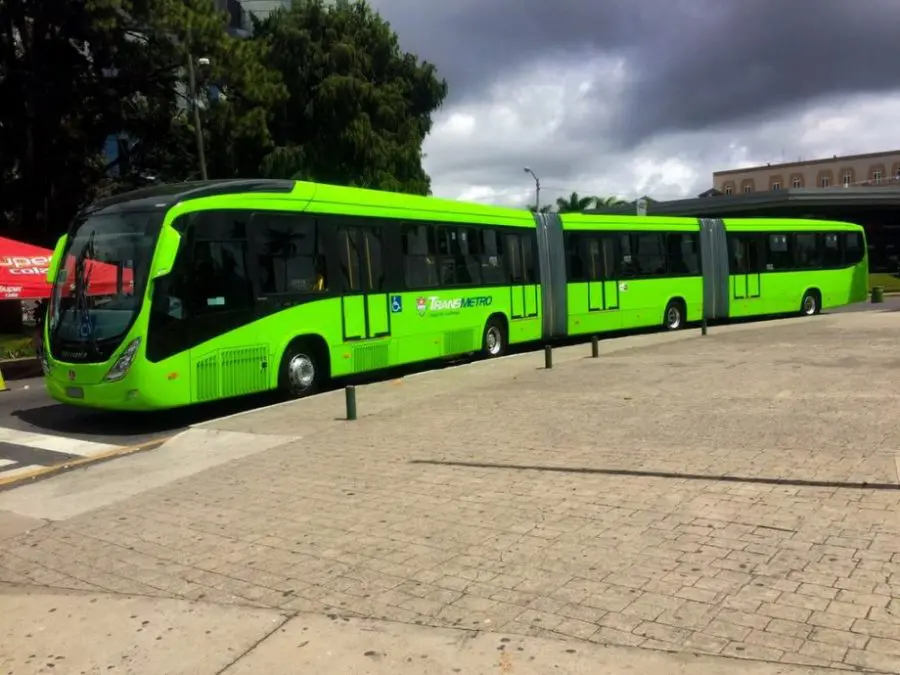
Visualizing sustainable transportation is key to understanding its broad and positive impact on our world.
This vision of the future involves diverse modes of transport that are efficient, accessible, and, above all, minimal in their environmental footprint.
By examining case studies, imagining future possibilities, and observing the transformative effects on communities, we can gain a clearer picture of what sustainable transportation entails and why it’s a goal worth striving for.
Case Studies: Examples from Around the World
- Copenhagen, Denmark: Known as the cycling capital of the world, Copenhagen showcases an urban environment designed with bike lanes, bridges, and signals that prioritize cyclists, resulting in over 40% of all commutes being made by bike.
- Curitiba, Brazil: This city is celebrated for its innovative Bus Rapid Transit (BRT) system, which operates like an above-ground subway, offering fast, reliable, and efficient public transport, significantly reducing car dependency.
- Oslo, Norway: Oslo has implemented a range of measures to reduce car use in the city center, including removing parking spaces, investing in bike lanes, and making the entire city center car-free by 2019, prioritizing pedestrian and cycling infrastructure.
Future Visions: Predictions and Plans for the Next Decades
- Electric and Autonomous Vehicles: The widespread adoption of electric vehicles (EVs), complemented by autonomous driving technology, is expected to reduce emissions and improve traffic efficiency.
- Integrated Mobility Solutions: A seamless integration of various transport modes, from public transit to ride-sharing and autonomous buses, facilitated by digital platforms, will offer personalized and efficient travel options.
- Smart Cities: Urban areas will increasingly incorporate technology to optimize traffic flow, improve safety, and reduce environmental impacts, making cities more livable and transportation more sustainable.
Community Impact: How Sustainable Transport Transforms Local Areas
- Improved Air Quality and Public Health: Communities that embrace sustainable transport see notable improvements in air quality, which directly benefits residents’ health by reducing diseases associated with air pollution.
- Enhanced Social Equity: Sustainable transportation systems that are affordable and accessible to all, including low-income and disadvantaged communities, help bridge the mobility gap and foster social inclusion.
- Economic Opportunities: Investing in sustainable transportation can spur local economic development by creating jobs, stimulating tourism, and enhancing the overall quality of life that attracts businesses and residents alike.
- Revitalized Urban Spaces: Cities that reduce car dependency often repurpose former roadways and parking lots into parks, playgrounds, and public spaces, enriching community life and fostering a sense of place.
Sustainable transportation is not just about reducing emissions; it’s about creating environments that promote health, happiness, and well-being.
By learning from successful case studies, planning for future innovations, and recognizing the community benefits, we can all contribute to and support the transition toward sustainable transportation models.
This vision for a greener, more equitable transportation future is not only achievable but essential for the long-term sustainability of our planet and the quality of life for generations to come.
Most Eco-Friendly Transportation
Identifying the most eco-friendly modes of transport is crucial for individuals looking to make environmentally responsible choices in their daily commutes and travels.
These modes of transportation not only minimize the environmental impact but also contribute significantly to urban sustainability and public health.
From the zero-emission benefits of biking and walking to the efficiency of public transit and the innovative potential of electric and hybrid vehicles, each option offers a pathway to a greener future.
Biking and Walking: The Zero-Emission Champions
- Environmental Benefits: Biking and walking produce zero emissions, making them the most eco-friendly way to travel. They eliminate the need for fossil fuels, reducing air pollution and carbon footprint.
- Health Advantages: Beyond environmental impact, biking and walking improve physical health and well-being due to increased physical activity.
- Urban Design: The rise in pedestrian-friendly urban designs and bike infrastructure, like dedicated lanes and bike-sharing programs, supports the adoption of these modes of transport.
- Example: Cities like Amsterdam and Copenhagen have successfully integrated biking into daily life, with extensive networks of bike lanes encouraging a high percentage of commutes by bicycle.
Public Transit: Buses, Trains, and Trams as Sustainable Options
- Efficiency at Scale: Public transit systems move large numbers of people efficiently, significantly reducing the per capita emissions compared to individual car use.
- Investments in Green Technology: Many cities are transitioning their public transit fleets to electric or hybrid models, further reducing greenhouse gas emissions.
- Accessibility and Affordability: Public transit provides equitable access to transportation, especially in dense urban areas where not everyone can afford a car or choose to bike or walk long distances.
- Example: Tokyo’s extensive and efficient public transportation system serves as a model for reducing reliance on personal vehicles, showcasing how buses, trains, and trams can form the backbone of urban mobility.
Electric and Hybrid Vehicles: Their Role in a Greener Future
- Cutting-edge Efficiency: Electric vehicles (EVs) and hybrids represent a significant leap forward in reducing emissions from the transportation sector, with EVs offering zero tailpipe emissions.
- Renewable Energy Integration: The environmental impact of EVs and hybrids continues to decrease as the electricity grid becomes greener with renewable energy sources.
- Government Incentives: Tax rebates, subsidies, and investments in charging infrastructure are making EVs and hybrid vehicles more accessible to the general public.
- Example: Norway’s push for electric vehicle adoption, supported by substantial government incentives, has led to one of the highest rates of EV ownership in the world, significantly lowering the country’s transportation emissions.
Through the adoption of biking, walking, public transit, and electric or hybrid vehicles, individuals and communities can significantly contribute to environmental sustainability.
Each of these eco-friendly transportation modes offers unique benefits and, when combined, can lead to substantial reductions in carbon emissions, improved urban air quality, and enhanced public health.
As technology advances and cities continue to evolve, these sustainable transportation options become increasingly integral to our vision of a cleaner, greener future.
What Is the Future of Sustainable Transportation?
The future of transportation is poised to be greener, more efficient, and more inclusive than ever before.
With climate change and urbanization posing significant challenges, the coming years will see an accelerated shift towards sustainable transportation solutions.
This shift will be driven by technological innovations, evolving policies, and global movements towards environmental sustainability.
By exploring upcoming trends and innovations, we can get a glimpse into how our mobility needs will be met in ways that prioritize the planet and its inhabitants.
Emerging Technologies: From Autonomous Vehicles to Hyperloop
- Autonomous Vehicles: Self-driving cars promise to revolutionize transportation by optimizing traffic flow, reducing accidents, and lowering emissions through more efficient driving patterns.
- Electric Mobility: The continued advancement in battery technology will make electric vehicles (EVs) more affordable and accessible, further reducing reliance on fossil fuels.
- Hyperloop and High-speed Rail: Innovative transport systems like the Hyperloop propose to drastically cut travel times between major cities using near-vacuum tubes and magnetic levitation, offering a high-speed, low-emission alternative to air travel.
- Urban Air Mobility: Concepts such as drones and flying taxis are being explored to utilize airspace for personal and public transport, aiming to reduce congestion on urban roads.
Policy Evolution: How Laws and Regulations Will Adapt
- Strengthening Emission Standards: Governments worldwide are expected to introduce stricter emission standards for vehicles, pushing manufacturers to develop cleaner, more efficient transportation options.
- Incentives for Green Choices: Policies such as tax rebates for EV purchases, investments in charging infrastructure, and subsidies for public transit can encourage sustainable transportation.
- Zoning and Urban Planning Regulations: Changes in zoning laws to promote transit-oriented development will facilitate the creation of communities where sustainable transport is not just an option but a preference.
- International Agreements: Global agreements on climate change, like the Paris Agreement, will continue to influence national policies, encouraging a shift towards sustainable transportation to meet carbon reduction targets.
Global Movements: International Cooperation for Sustainable Mobility
- Cross-border Infrastructure Projects: International projects like the development of transnational railway networks in Europe and Asia enhance connectivity and offer sustainable alternatives to air and road travel.
- Shared Technology and Innovation: Countries and companies are increasingly collaborating on research and development projects to advance sustainable transportation technologies, such as hydrogen fuel cells and shared mobility platforms.
- Global Standards for Sustainable Transport: Efforts to establish international standards for emissions, vehicle efficiency, and sustainable urban planning are helping to harmonize efforts across borders, ensuring a global approach to reducing transportation’s environmental impact.
The future of sustainable transportation envisions a world where mobility is not only about reaching our destination but doing so in a way that is harmonious with our planet.
Emerging technologies, coupled with forward-thinking policies and global cooperation, are paving the way for this future.
As we move forward, it’s clear that sustainable transportation will play a pivotal role in shaping our cities, economies, and the environment, promising a cleaner, more equitable world for future generations.


